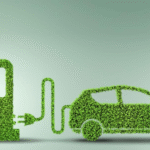The need for Financing to support the budding Indian EV Industry – The worldwide automobile field is currently going through a gradual but huge paradigm shift. It is slowly moving to substitute and energy-efficient options, to prevent the negative impacts of traditional fuel-driven vehicles. However, India is making similar efforts to conduct the mobility move to electric vehicles. Increasing worries about pollution levels, the effects of global climate change oil imports, and other problems have necessitated this action. With the aid of foreign direct investment (FDI), the electric vehicle (EV) field in India is extending in size and strength, which has outcome in the beginning of new production facilities and charging stations.

Localized ACC battery manufacture and storage, federal subsidiaries, incentive programs, and discount policies for Indian-made electric two-wheelers are some of the main factors propelling the extension of the Indian EV market. A production-linked incentive program for the development of electric and hydrogen fuel cell vehicles was accepted by the Cabinet in September 2021. With the right support from the finance field, these actions guarantee that India’s electric vehicle field thrives. It will be advantageous to learn more about the Indian EV Industry.
Trends and Ways Of EV Industry
The automotive sector in India comes fifth worldwide, in terms of market size. It is hoped to become the third biggest by the year 2030. Due to its wide domestic market, federal policies are proceeding towards a mobility option that is shared, connected, and electric. The target is to get 100% electrification of vehicles by 2030. According to a study by the CEEW Centre for Energy Finance (CEEW-CEF), the Indian EV market will become a US$206 billion opportunity by 2030, if the stable growth is continued. To gain this, a cumulative investment of more than US$180 billion is needed in vehicular production and charging infrastructure across the country.
A report by the Indian Energy Storage Alliance (IESA) states that the EV market in India will rise at a CAGR of 36% until 2026, along with a CAGR of 30% growth in the EV battery market. These aspiring figures point towards the wide demand for electric vehicle financing India requires right now.
EV Financing in India
The electric vehicle market in India is still at just the beginning stage and has been badly impacted by the COVID-19 pandemic. Still, it is growing rapidly with financing help. Along with federal policies, private eCommerce organizations such as Amazon are also concentrating efforts on EV financing. Amazon had a mortgage to utilize e-vehicles for last-mile deliveries. However, the government also launched electric inter-city buses in some places. State Governments are also leasing in policies to invite more financing for this market. Kerala government aims to bring 6,000 e-buses by 2025 and Telangana has plans to raise EV sales targets for 2025 to 80% for two- and three-wheelers, such as scooters, auto-rickshaws, and motorcycles.
Moreover, the goal is to get 70% of commercial 40% of buses, cars, 30% of private cars, and 15% of all vehicles moved to electrification by 2025. The collaborative investment done by component makers, delivery organizations, and commercial vehicle owners for e2W and e4W vehicles was INR 25,045.31 crores from January to July 2021. Since this industry enables 100% FDI, this figure is hoped to grow excessively.
India’s Electric Vehicle Financing Difficulties
In the Indian market, funding for e-vehicles has been beset by certain different difficulties. It all boils down to how EVs can be broadly embrace in place of the following difficulties.
- High insurance premiums, high interest rates, a lack of specialist finance options, and poor loan-to-value ratios are some of the funding difficulties.
- Establishing a charging structure, executing clear policies, and providing specialized EV financing are some of the regulatory difficulties.
- Since EV finance is known as riskier than regular vehicle financing, high risk notably discourages investor participation.
- Lenders’ worries stem from the sector’s infancy and lack of balance.
EV Customers’ Financial Inclusion Facilitation
Only until EV is more broadly marketed and combined into families’ and companies’ everyday lives can financial inclusion for customers be ensured. For both the bank and the customer, this calls for long-term financing plans for electric automobiles. It is essential to keep in mind that the extension of the EV field may be a direct outcome of technological acceptance. This means that the more we enable the technology to be embraced, the wider the market will be, which will lead to additional financing options. India’s EV market is hoped to grow into one of the biggest and most dynamic in the world with the support of government and private investment.
FAQs
What is the Electric Vehicle financing market in India?
The India Electric Vehicle Financing Market size is rised at USD 2.37 billion in 2025 and is hoped to reach USD 19.97 billion by 2030, at a CAGR of 53.16% during the predicted period (2025-2030).
What are the main success factors of the EV industry?
Success in the electric vehicle market depends on planned alignment in five main areas: using government incentives, optimizing the total cost of ownership, communicating environmental advantages, extending the charging structure, and aligning supply with demand.
What are the main customer benefits given by an EV motor?
Decreasing carbon emissions, reducing operating costs, reducing noise pollution in urban areas, and reducing dependence on fossil fuels.








